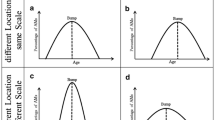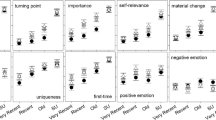Abstract
We describe a study in which young and older groups of Bangladeshi participants recalled and dated autobiographical memories from across the lifespan. Memories were subsequently plotted in terms of the age of participants at time of encoding. As expected the reminiscence bump, preferential recall of memories from the period of 10 to 30 years of age, was observed. This was very marked in the younger group and but less so in the older group who also showed a second bump in the period 35 to 55 years of age. This second bump corresponded to the period of national conflict between Pakistan and the Bengalee people that resulted in the formation of an independent Bangladesh. It is proposed that both the reminiscence bump and later periods of unexpected rises in recall can be accounted for by the raised accessibility of sets of memories and this in turn is a product of the privileged encoding of highly self-relevant experiences.
Similar content being viewed by others
REFERENCES
Anderson, S. J., & Conway, M. A. (1993). Investigating the structure of autobiographical memories. Journal of Experimental Psychology: Learning, Memory, and Cognition, 19, 1178-1196.
Anderson, S. J., & Conway, M. A. (1997). Representations of autobiographical memories. In M. A. Conway (Ed.), Cognitive models of memory (pp. 217-246). Hove, Sussex, England: Psychological Press.
Brown, R., & Kulik, J. (1977). Flashbulb memories. Cognition, 5, 73-99.
Benson, K. A., Jarvi, S. D., Arai, Y., Thielbar, P. R., Frye, K. J., & Goracke McDonald, B. (1992). Socio-historical context and autobiographical memories: Variations in the reminiscence phenomenon. In M. A. Conway, D. C. Rubin, H. Spinnler, & W. A. Wagenaar (Eds.), Theoretical perspectives on autobiographical memory (pp. 313-321). Dordrecht, The Netherlands: Kluwer.
Carver, C. S., & Scheier, M. F. (1982). Control theory: A useful conceptual framework for personality-social, clinical, and health psychology. Psychological Bulletin, 92, 111-135.
Carver, C. S., & Scheier, M. F. (1990). Origins and functions of positive and negative affect: A control-process view. Psychological Review, 97, 19-35.
Conway, M. A. (1990). Autobiographical memory: An introduction. Buckingham, England: Open University Press.
Conway, M. A., (1995). Flashbulb memories. Brighton, Sussex, England: Erlbaum.
Conway, M. A. (1996). Autobiographical memories and autobiographical knowledge. In D. C. Rubin (Ed.), Remembering our past: Studies in autobiographical memory (pp. 67-93). Cambridge, England: Cambridge University Press.
Conway, M. A. (1997). The inventory of experience: memory and identity. In D. Jodelet, J. Pennebaker, & D. Paez (Eds.), Political events and collective memories (pp. 21-46). London, England: Routledge.
Conway, M. A., Anderson, S. J., Larsen, S. F., Donnelly, C. M., McDaniel, M. A., McCelland, A. G. R., Rawles, R. E., & Logie, R. H. (1994). The formation of lashbulb memories. Memory & Cognition, 22, 326-343.
Conway, M. A., & Bekerian, D. A. (1987). Organization in autobiographical memory. Memory & Cognition, 15, 119-132.
Conway, M. A. & Holmes, A. (1997, January). Flashbulb memories and generation identity. Paper presented at the meeting of the Experimental Psychology Society, University College, London.
Conway, M. A., & Pleydell-Pearce, C. W. (1998). On the construction of autobiographical memories: The self-memory system and its neuroanatomical basis. Manuscript submitted for publication.
Conway, M. A., & Rubin, D. C. (1993). The structure of autobiographical memory. In A.E. Collins, S.E. Gathercole, M. A. Conway, & P. E. M. Morris (Eds.), Theories of memory (pp. 103-137). Hove, Sussex, England: Erlbaum.
Craik, F. I. M., & Lochart, R. S. (1972). Levels of processing: A framework for memory research. Journal of Verbal Learning and Verbal Behavior, 11, 671-684.
Csikszentmihalkyi, M., & Beattie, O. V. (1979). Life themes: A theoretical and empirical exploration of their origins and effects. Journal of Humanistic Psychology, 19, 45-63.
Erikson, E. H. (1950). Childhood and society. New York: W. W. Norton & Company.
Fitzgerald, J. M. (1988). Vivid memories and the reminiscence phenomenon: The role of a self narrative. Human Development, 31, 261-273.
Fitzgerald, J. M., & Lawrence, R. (1984). Autobiographical memory across the lifespan. Journal of Gerontology, 39, 692-698.
Franklin, H. C., & Holding, D. H. (1977). Personal memories at different ages. Quarterly Journal of Experimental Psychology, 29, 527-532.
Fromholt, P., & Larsen, S. F. (1992). Autobiographical memory and life-history narratives in aging and dementia (Alzheimer type). In M. A. Conway, D. C. Rubin, H. Spinnler, & W. A. Wagenaar (Eds.), Theoretical perspectives on autobiographical memory (pp. 413-426). Dordrecht, The Netherlands: Kluwer.
Haque, S. (1999). Investigating the retrieval of autobiographical memories. Unpublished doctoral dissertation, Department of Experimental Psychology, Univeristy of Bristol, England.
Holmes, A., & Conway, M. A. (1999). Generation identity and the reminiscence bump: Memory for public and private events. Journal of Adult Development, 6 (this issue).
Igartu, J., & Paez, D. (1997). Art and remembering traumatic collective events: The case of the Spanish civil war. In D. Jodelet, J. Pennebaker, & D. Paez (Eds.). Political events and collective memories (pp. 79-102). London, England: Routledge.
Jansari, A., & Parkin, A. J. (1996). Things that go bump in your life: Explaining the reminiscence bump in autobiographical memory. Psychology and Aging, 11, 85-91.
Linton, M. (1986). Ways of searching and the contents of memory. In D. C. Rubin, (Ed.), Autobiographical memory (pp. 50-67). Cambridge, England: Cambridge University Press.
Mannheim, K. (1952). The problem of generations. In K. Mannheim (Ed.), Essays on the sociology of knowledge (pp. 276-321). London, England: Routledge & Keegan Paul.
Paez, D., Basabe, N., & Gonzalez, J. L. (1997). Social processes and collective memory: A cross-cultrual approach to remembering. In D. Jodelet, J. Pennebaker, & D. Paez (Eds.), Political events and collective memories (pp. 147-174). London, England: Routledge.
Rime, B., & Christophe, V. (1997). How individual emotional episodes feed collective memory. In D. Jodelet, J. Pennebaker, & D. Paez (Eds.), Political events and collective memories (pp. 131-146). London, England: Routledge.
Robinson, J. A. (1992). First experience memories: Contexts and function in personal histories. In M. A. Conway, D. C. Rubin, H. Spinnler, & W. A. Wagenaar (Eds.), Theoretical perspectives on autobiographical memory (pp. 223-239). Dordrecht, The Netherlands: Kluwer.
Rubin, D. C., Rahhal, T. A., & Poon, L. W. (in press). Things earned in early adulthood are remembered best. Memory & Cognition.
Rubin, D. C., & Schulkind, M. D. (1997). The distribution of autobiographical memories across the lifespan. Memory & Cognition, 25, 859-866.
Rubin, D. C., Wetzler, S. E., & Nebes, R. D. (1986). Autobiographical memory across the adult lifespan. In D. C. Rubin (Ed.), Autobiographical memory (pp. 202-221). Cambridge, England: Cambridge University Press.
Schuman, H., Belli, R. F., & Bischoping, K. (1997). The generational basis of historical knowledge. In D. Jodelet, J. Pennebaker, & D. Paez (Eds.), Political events and collective memories (pp. 47-78). London, England: Routledge.
Schuman, H., Rieger, C., & Gaidys, V. (1994). Collective memories in the United States and Lithuania. In N. Schwarz & S. Sudman (Eds.), Autobiographical memory and the validity of retrospective reports (pp. 313-334). New York: Springer-Verlag.
Schuman, H., & Scott, J. (1989). Generations and collective memories. American Sociological Review, 54, 359-381.
Singer, J. A., & Salovey, P. (1993). The remembered self. New York: The Free Press.
Strauman, T. J. (1990). Self-guides and emotionally significant childhood memories: A study of retrieval efficiency and incidental negative emotional content. Journal of Personality and Social Psychology, 59, 869-880.
Strauman, T. J. (1996). Stability within the self: A longitudinal study of the structural implications of self-discrepancy theory. Journal of Personality and Social Psychology, 71, 1142-1153.
Wetzler, S. E., & Sweeney, J. A. (1986). Childhood amnesia: An empirical demonstration. In D. C. Rubin (Ed.), Autobiographical memory (pp. 202-221). Cambridge, England: Cambridge University Press.
Author information
Authors and Affiliations
Corresponding author
Rights and permissions
About this article
Cite this article
Conway, M.A., Haque, S. Overshadowing the Reminiscence Bump: Memories of a Struggle for Independence. Journal of Adult Development 6, 35–44 (1999). https://doi.org/10.1023/A:1021672208155
Issue Date:
DOI: https://doi.org/10.1023/A:1021672208155




